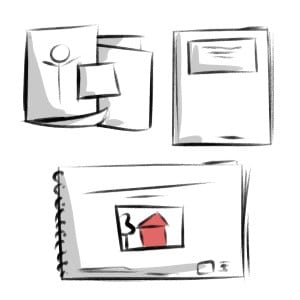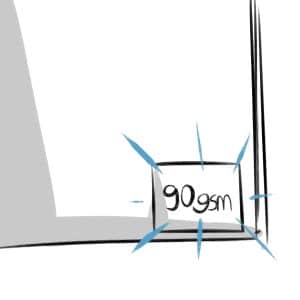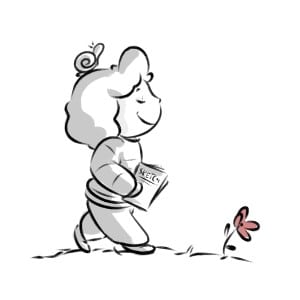As with a good Sketchbook, having the best Drawing Paper is very important!
I’ve tried a lot of paper throughout the years, from cheap light paper that is used for printing documents to high-quality heavy cartridge paper for painting.
Printing paper isn’t the best for drawing unless you’re just doing some very quick and messy doodles. But even for that, I’d prefer to use a paper that’s more suitable for it.
According to the different medium that you’re using, you’ll want different paper!
The Best Drawing Paper At A Quick Glance
Editor’s Choice
The Best Overall Paper. If you just want drawing paper for most scenarios, get this one!
- For Sketching
- Graphite Drawings
- Charcoals
Best Paper For Ink
Prefer to draw with ink and pen? This is the best drawing paper for you.
- Perfect For Pen
- And Ink
Best Paper For Watercolor
A heavier, super smooth paper for watercolor and pastel!
- For Watercolor
- And For Pastel!
So let’s go over the best drawing paper for artists for every medium.
One at a time, so that you can choose the right paper for you!
Best Overall Drawing Paper
The best drawing paper for artists is the Drawing Pad from Canson XL (check the best price on Blick’s Art Materials).
This drawing paper is a great choice for artists that work in:
- Graphite pencils
- Coloured pencils
- Charcoal drawing
- Pen and Ink drawing
Either if you’re using this paper for charcoal, sketching with graphite or even coloring, this is the one to get. I can highly recommend the Drawing Pad, from the Canson XL series, it’s a very big pad of paper, with 30 large sheets!
You have a lot of space to draw, and you can even cut each sheet into smaller ones, so you have a smaller canvas to work with.
Although not the thickest, it already falls in the Cartridge paper category, with 114gsm, it already has a nice weight for simple doodling or to use graphite and colored pencils.
If you’re interested in knowing more about Cartridge paper and why it’s so important, along with some curiosities, I do talk about it, in more detail, in this other article.

With all of this said, I wouldn’t recommend it to use for wet media such as gouache and paints. And if you’re planning on doing some airbrushing, the paper might curl a bit.
This is a high-quality paper for pencil artists, and many professional artists use it even today. So if you’re looking some quality sketching paper, I recommend the Drawing Pad from Canson XL.
Best Drawing Paper For Ink
If you’re a fan of mixed media and drawing with ink, the best paper for ink is the Bachmore Drawing Pad.
With quite thick pages (160g) and a great size, you can’t beat the price of this paper. Especially if you’re using ink!
It can work very well for drawing with pencil, but I wouldn’t say this is the best paper for graphite. (Instead, get the previous one I mentioned).
With that said, this acid-free paper is quite durable and smooth to work with.
So if you’re working with different drawing medium or just want to focus on drawing with ink, get this heavier, quality paper!
Best Drawing Paper For Watercolor
For painting with watercolor, the best drawing paper is the Canson XL Series Watercolor Textured Paper Pad.
This is a very comfortable pad of smooth paper, and it’s a perfect drawing surface for painting with watercolor because it is a heavyweight drawing paper.
Thinner paper will be fine for sketching, but if you plan on using watercolor and other wet media, heavier paper with 300gsm or more is a much better choice.
The Canson Textured Paper is acid-free, with a nice amount of texture, and is very comfortable to use. Not only that, but the colors pop with vibrancy when you apply them!
I cover the best watercolor supplies (including paper) in this article here!
Different Types Of Drawing Paper
When it comes to drawing paper (or art paper) there are several types of drawing paper available for artists to choose!
You probably stumbled into an art store before and were overwhelmed with how many paper surfaces there were to buy.
Generally, there are 3 types of drawing paper texture that you can choose from: Hot Pressed, Cold Pressed, and Rough.

Hot Pressed paper usually has a very smooth surface, and it’s perfect for detailed drawings and illustrations. You get amazing control over your pen or pencil work. For example the Strathmore 500 Series Hot Press.
Cold Pressed paper has a slight texture to it, this is usually called “tooth”. In general, it’s a very versatile paper suitable for watercolor, gouache, pen and acrylic. It can create beautiful washes and soft blending effects. As an example, you have the Winsor & Newton Watercolor Paper Pad.
Rough paper is the type of paper with the most amount of texture among the three different types. It is very coarse and texture, which gives a lovely grainy look to your artwork. If you enjoy working with charcoal, pastels and use dry brush techniques, this is the paper for you! As an example of a very rough paper, you have the Bee Paper Quick Rough Sketch Pad.
Be sure to keep an eye on which type of drawing paper you’re getting before making a decision! Different types of paper will give you VERY different results on your final artwork.
Features to Look for in Drawing Paper
There are at least 4 things to take into consideration when choosing the best drawing paper:
- Weight Or Thickness
- Your Medium
- Size
- Texture
Let’s go over them.
Weight Or Thickness
Depending on what you’re using your paper for, you’ll need different kinds of paper weight.
How do you know how thick your paper is without feeling it? Very easily.
Somewhere on the front (sometimes, very rarely, on the back) of your pad you’ll see a number followed by a “g” or a set of letters that read “gsm” (grams per square meter).
This is what you’re looking for.
This number tells you how thick each sheet of paper is.
A higher gsm means that it’s a thicker and more durable paper, this weight of paper allows you to use wet media without curling, buckling, or tearing easily!
Your Specific Medium
You must choose the best paper according to the medium you’re using.
Anything below 100gsm is very thin. In my opinion, even for sketching, 90gsm is the lowest you should go.
Anything lower than that is usually very thin and smooth. Some marker pads have very low grammage, but the materials themselves are different.
So unless you’re looking for a specific paper, for a specific medium, or you want to use it for writing or even to fold it, you’ll want something with 90gsm and more.

If you want to draw watercolors or even another kind of paint, you won’t want anything lower than 300gsm.
Lower than that, your paper will most likely wrinkle and bleed when applying anything wet, be it the water or the paint itself. Depending on how much paint you’re adding or how many layers, you might want a paper that’s even thicker than that.
In short, anything between 100gsm and 300gsm is good for graphite, charcoal, pastel, ink pens and colored pencils.
If you’re using watercolors or acrylics, you need thicker paper, with 300gsm or more.
Aside from that, it’s all a matter of taste and what you prefer to draw on. Be it watercolor, charcoal, colored pencils or other media.
Size
Pads come in all sizes. I really recommend always having a bigger pad.
It’s the pad that stays at home, that you’ll pick up whenever you feel like relaxing a bit with some drawing, in the afternoon.
But, of course, you might want to bring a pad with you at all times. And for that, there are smaller pads.
An A5 size is already small enough to sit comfortably in your purse or backpack as you walk around, along with some pencils.

If you attend drawing classes, you’ll probably be asked for a specific size of paper, usually A3.
So picking up the size of paper you want depends either on your taste, as in, how big you like to draw on; what is required for you to use, in case of attending art classes and finally, if you have a single place to draw, or if you prefer to walk around, sit at a garden and draw on the go.
With that said, here are the best Sketchbooks I Recommend For Every Medium!
Texture
Last, but not least, there’s the texture of the paper.
Some pads have very minimal grain, making the paper very smooth. Others have a nice texture that will feel great drawing on.
And finally, there’s some paper, made of different and recycled materials, that makes it very textured. Once again, it all depends on what you want to draw and what you like the best.

Personally, I like to have some texture on my paper.
Not a lot, but enough that I can feel it underneath my pencil when drawing.
Try out different kinds of papers and textures until you find the perfect fit for you!
Ready to draw some people? Here are the Basics of Figure Drawing For Artists!


